
Prevent Cross-Site Tracking on Motorola G54 5G and Browser | Dr.fone

Prevent Cross-Site Tracking on Motorola G54 5G and Browser
Have you ever wondered why you get the advertisements of the websites you visited a few minutes ago on your social media sites? Here comes to Cross-Site Tracking, also termed CST, and it is a process where third-party cookies and sites track your browser history.
![]()
The CST process is like invading your privacy by collecting your browser history and personal information. So, to prevent these services, there are several ways by which you can cross-site tracking on your system as well as Motorola G54 5G phone browsers. Keep reading to learn how to stop cross-site tracking on both Motorola G54 5G and browser.
Part 1: Why Do We Need to Stop Cross-site Tracking?
Cross-site Tracking is all about collecting your browsing data and other information for advertising purposes. Though the process can prove convenient for many as it provides additional information about the products and services you have searched for and offers tailor-made content, it is intrusive and about breaching your privacy.
Cross-site tracking collects information about your browsing history. The third-party cookies also monitor the content type you have visited and your personal information, which is risky.
Besides invading privacy, the CST also poses several other issues. Based on your browsing history, additional content you have not asked for is loaded on your visited sites, slows down the page loading process, and puts an extra burden on your battery. Moreover, too much-unwanted content can interfere with the basic information you are looking for.
So, it is always better to prevent cross-site tracking for all the above and more reasons.
Further reading: A detailed guide on faking location in Mozilla Firefox . Don’t worry about your location privacy anymore!
Part 2: Can Private Browsing be traced?
Yes, private browsing can be traced. When you work in private browsing mode, the web browser does not save the browsing history, which means that anyone who uses your system will not check your online activities. But websites and cookies can track your browsing history as well as other information.
Part 3: How to Disable Cross-website Tracking on Safari for iOS Devices?
Safari is the most commonly used platform by iOS users. So, to prevent CST for Safari on your iOS devices and Mac systems, below is a complete guide.
Deactivate Safari cross-website tracking for iPhone & iPad
Safari cross-site tracking can be prevented using the below steps on your iPhone and iPad.
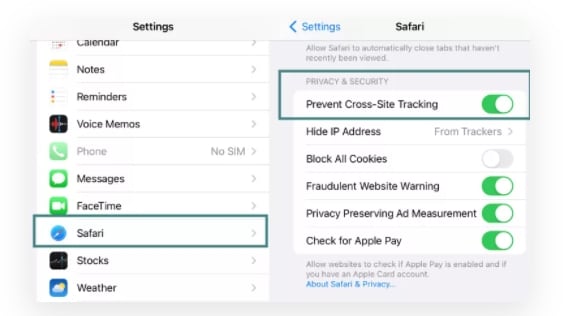
- Step 1. Launch the Settings app on your iOS device.
- Step 2. Find the Safari option by scrolling down the menu.
- Step 3. Move the slider to turn on “Prevent Cross-Site Tracking” under the PRIVACY & SECURITY option.
Deactivate Safari cross-website tracking for Mac
Use the steps below to turn off cross-site tracking on Safari on your Mac systems.

- Step 1. On your Mac system, open the Safari app.
- Step 2. Move to Safari > Preferences > Privacy
- Step 3. Enable the “Prevent cross tracking” option by clicking on the box next to it.
Part 4: How to Disable Cross-site Tracking on Google Chrome
Chrome is used widely on Windows systems and Android devices, and to prevent the CST from your browser, a detailed guide is given below.
Enable “Do Not Track” on Google Chrome for Android
- Step 1. On your Motorola G54 5G, open the Chrome app.
- Step 2. At the right side of the address bar, click on the More option and choose Settings.
- Step 3. Choose the Privacy option from the Advanced tab.
- Step 4. Click on the “Do Not Track” option to turn on the feature.

Enable “Do Not Track” on Google Chrome for Computer
- Step 1. Launch Chrome on your system, and from the menu at the upper-right corner, click on the Settings option.
- Step 2. From the “Privacy and Security” tab, choose the “Cookies and other site data” option.
- Step 3. Tap and enable the slider next to “Send a “Do not track” request with your browsing traffic.”
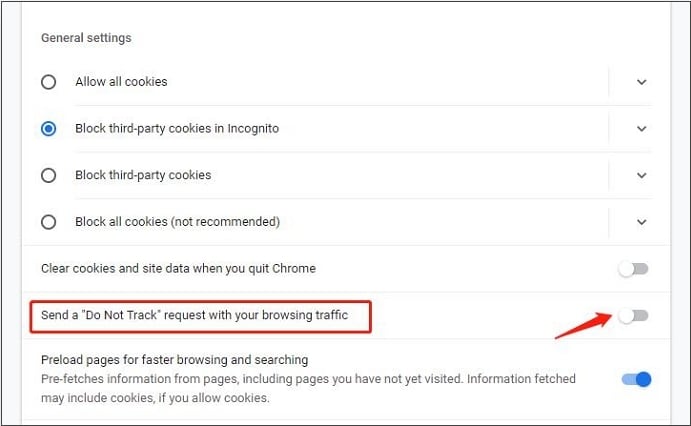
Part 5: Recommended Solution: Fake a Location to Stop Cross-Site Location Tracking Using Dr. Fone
What if you let the sites and cookies track your phone location without worrying about your privacy? Yes, it can be done by spoofing your location. So, if you set a fake location while browsing the internet, you will not have to worry about cross-site tracking, as anyways, the sites and cookies will get misled browsing information that cannot harm you in any manner.
Setting a fake location on your iOS devices, a professional tool is needed, for we recommend Wondershare Dr.Fone - Virtual Location as the best tool. Using this Android and iOS-based software, you can set any fake GPS location on your device. The tool is simple to use and does not require any mastery of technical know-how.
Key features
- Simple tool to teleport to any GPS location in a single click.
- Allows simulating GPS movement along the route.
- All popular models of Android and iOS devices are compatible.
- Compatible with all location-based apps on your phone.
- Compatible with Windows and Mac systems.
Here is a video tutorial for you to take an overview of how to use Dr.Fone - Virtual Location to fake location on your Android and iOS devices.

Steps to set fake location on your Android and iOS devices using DrFone-Virtual Location
Step 1. Download, install and launch the software on your Windows or Mac systems. On the main software interface, choose the Virtual Location option.

Step 2. Connect your iPhone or Android device to your system using a USB cable and then tap on the Get Started option on your software interface.
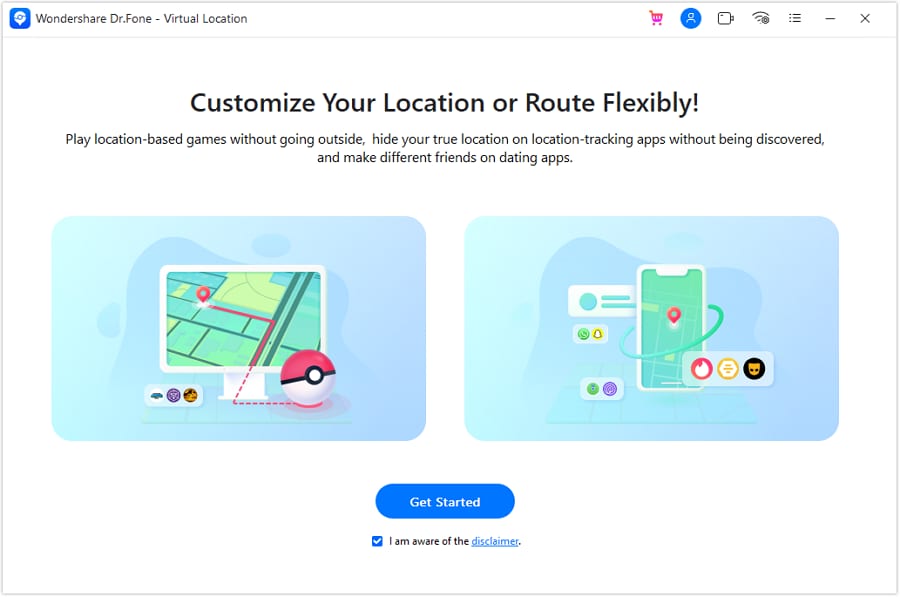
Step 3. A new window on the software interface will open, showing your connected phone’s real and actual location. If the detected location is incorrect, click on the “Center On” icon to display the right device location.
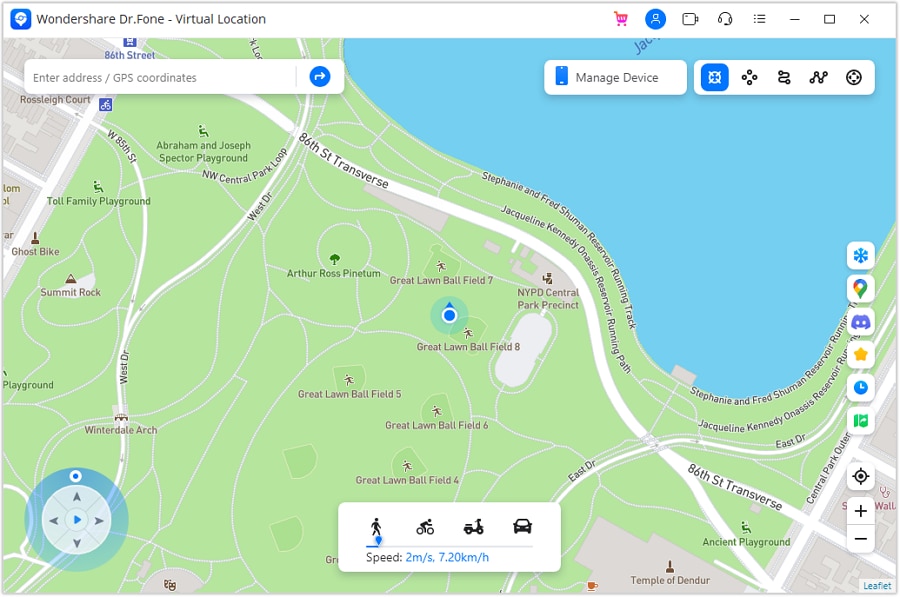
Step 4. Next, you need to activate the “teleport mode” and click o the 3rd icon at the upper-right corner.
Step 5. Next, you have to enter now the fake location to which you wish to teleport to at the upper-left corner. Click on Go.
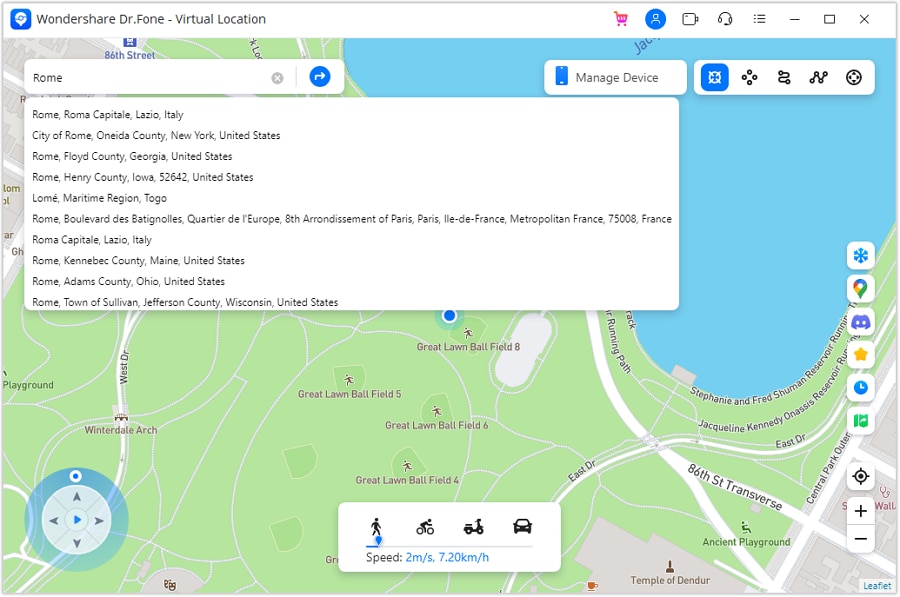
Step 6. Finally, tap on the Move Here button and the new fake location for your connected Android or iOS device at the pop-up box.
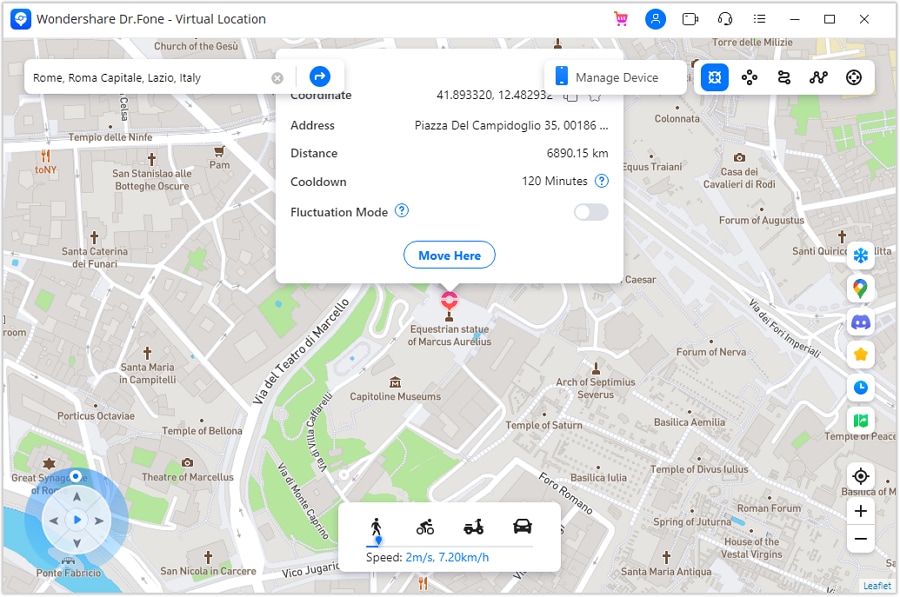
Check the new location of your phone from the app.
It will help you to write dynamic data reports easily, to construct intuitive dashboards or to build a whole business intelligence cockpit.
KoolReport Pro package goes with Full Source Code, Royal Free, ONE (1) Year Priority Support, ONE (1) Year Free Upgrade and 30-Days Money Back Guarantee.
Developer License allows Single Developer to create Unlimited Reports, deploy on Unlimited Servers and able deliver the work to Unlimited Clients.
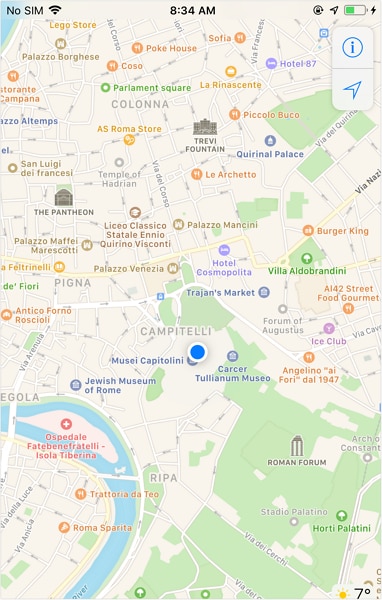
Wrap it up
Preventing Cross-site tracking can be done on different browsers and devices using the guides listed in the above parts of the article. Settings a fake location for your device using Dr. Fone-Virtual Location is another interesting way to prevent tracking your browsing history by spoofing the sites and cookies. Setting a fake place will not only avoid monitoring your browsing history but will also work with all location-based apps on your phone.

What is Geo-Blocking and How to Bypass it On Motorola G54 5G?
Have you ever entered a website and can’t access it because it is unavailable in your area? This is what geo-blocking means. If you want to know more about geo-blocking, you have come to the right article. This article provides the definition, symbols, function, type, and how to bypass a geo-blocked site.
Encryption is often used in geo-blocking as a means of protecting material that is restricted to users in just certain locations. In its long existence, the method has been met with several obstacles. These obstacles will be discussed in the next sections!
company, user or members of the same household. Action! - screen and game recorder</a>

Part 1. What is Geo-Blocking?
This section will give you the definition of geo-blocking. It will also show how websites inform viewers that they are in geo-blocking areas.
Definition of Geo-Blocking
Geo-blocking is the practice of restricting online access to certain users depending on where in the world they happen to be physically located. Telecommunications firms, websites, and other content providers and intellectual property owners often use this method for copyright protection. To monitor and enforce geo-blocks, databases that map out IP addresses’ geographical locations are often employed.
Understanding the Main Symbols and Elements
You sometimes can’t access a site because it isn’t available in your area. This is the main element carried by geo-blocking.
Every online-surfing tool has a unique identifier called “IP address”. The address can identify the Motorola G54 5G devices’ geographical location. When users access a website, their devices send their IP addresses to the online servers. The servers read if the IP addresses are included in the allowed list and determine whether to allow the visitors to view the content.
The visitors usually know they are geographically limited through the website’s displayed outcomes, a poster indicating that the service is unavailable in the location. Take the geo-banned access by Airbnb as an example below.
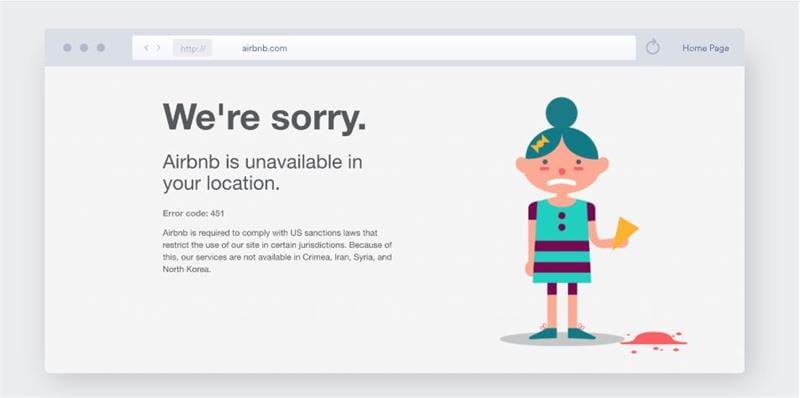
Although Airbnb has been criticized for posing a threat to the availability of low-cost lodging in metropolitan areas, it has proven to be a useful resource for travelers. However, not everyone can use it; for instance, it is unavailable in Iran due to US sanctions.
Part 2. How Does Geo-Blocking Work?
When a firm, rather than a government, is responsible for geoblocking, IP addresses are often the first line of defense. Your IP address is like a street address, revealing where you live.
IP addresses are numerical identifiers that distinguish each machine on the internet. Your computer’s IP address is sent to the server of the website you visit so that it may supply the required data.
You’ll be assigned an IP address when you sign up for an Internet Service Provider. It is possible to pinpoint the location of your device using its IP address, albeit the degree of precision may vary. Websites use the IP address to determine whether you can read their content. They will thus refuse your request if you are using an IP address that’s not on their approved list.
 HD Video Converter Factory Pro
HD Video Converter Factory Pro
Part 3. Common Types of Geo-blocked Content
The difficulty stems from legal hurdles, including copyrights, licenses, and territorial disputes. Certain streaming services may not make all of their offerings accessible in all regions, or a major online shop may restrict some of their offerings to customers in just one geographic area.
Youtube
Users who upload videos can restrict access to them in certain countries. This nearly usually indicates that a business has chosen that you shouldn’t be able to see a video because of where you are located.

Spotify
You may be trying to find a method to unblock Spotify because you want to listen to unavailable music in your country or because the app has been prohibited in your area.

Live Sports
Big events may be aired exclusively by one company, which means you may be forced to pay to access certain material or go through annoying subscription hoops.

Pandora
Do you want to tune in to this online radio and music station? You can’t access it anywhere in Europe because of a regional firewall.

Porn sites
Artists from porn sites can now geo-block their movies, much like YouTube users do. Some porn sites have been outlawed in several countries, including Egypt and Pakistan, where the vast majority of the population resides.

Amazon
Amazon Prime geo-blocks other services as well as its streaming content. Games, ebooks, software, audiobooks, and other digital materials like TV and movies may be licensed and copyrighted. Amazon Prime prevents certain VPN IPs from accessing foreign content, including Netflix.

Part 4. Tips to Bypass Geo-Blocking
While certain sites may be blocked in your country, there are still methods to access the full functionality of the web. What exactly are they, and how do you go about getting them? Here’s more reading material.
Method 1. Use Smart Domain Name System (DNS)
Clever DNS can evade geoblocking if your smart TV, streaming box, or gaming console doesn’t support VPNs or proxy servers. Some home routers can generate VPN connections, but not all.
By changing your DNS address, clever DNS may alter your device’s virtual location. Smart DNS replaces your Internet provider’s DNS server. Netflix.com’s IP is not netflix.com. You’ll acquire the smart DNS provider’s transparent DNS proxy IP. Netflix thinks you’re in the US since this proxy server is.
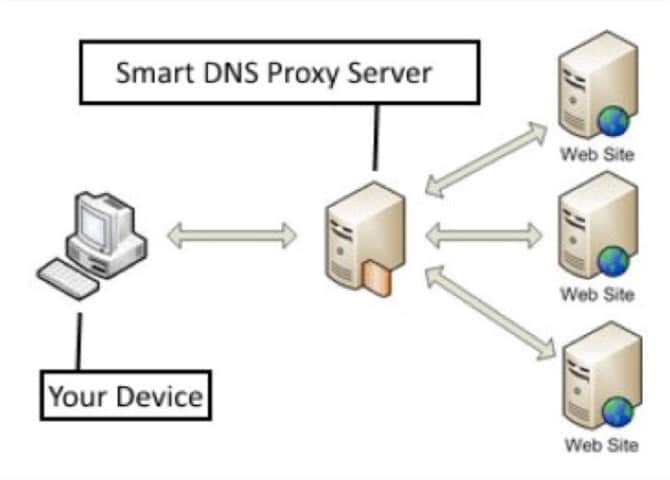
Method 2. Connect to Proxy Servers
Rather than connecting you directly to the server housing the material you want, a proxy server functions as an intermediary. A proxy server does what its name implies: it acts on your behalf to get access to the data and then forwards it to you. Proxy servers, especially those in foreign countries, may be used to get around geographical restrictions.
Depending on the kind of proxy server you use, you may or may not be able to conceal your IP address when surfing the web. Proxy servers are available online and may be accessed from any web browser. Setting up a proxy server is easy, but your activity may still be vulnerable since proxies don’t secure your data.
 FX PRO (Gold Robot + Silver Robot(Basic Package))
FX PRO (Gold Robot + Silver Robot(Basic Package))
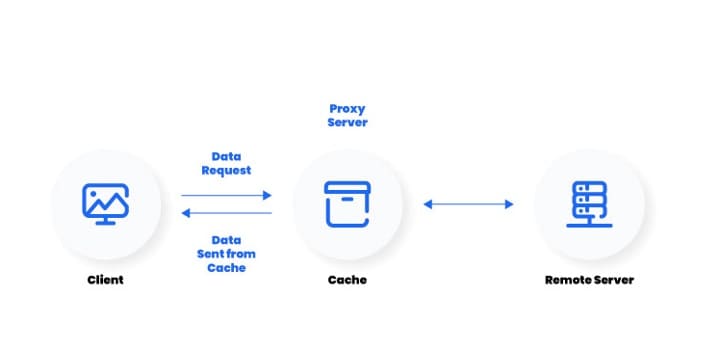
Method 3. Use the Tor Browser
In addition to using a VPN, you may use the anonymous Tor browser. The Tor browser links to the Tor network, a collection of computers that collaborate to conceal your online footprint by relaying your traffic via several intermediary nodes.
Tor employs a technique called “onion routing” to conceal its users’ identities. Since more time is required to traverse these additional levels, your internet speed may suffer as a consequence.
Method 4. A Good VPN Connection
A virtual private network (VPN) may hide your online identity and protect your data by encrypting your connection. VPNs allow you to get around geographically restricted material by redirecting your connection via a server in another country. This will allow you to connect to VPN servers in other countries, such as the United States, the United Kingdom, or Australia.
With effective VPN tools , you can surf the web anonymously, unblock geo-blocked content, and watch your favorite programs abroad. There are several advantages to utilizing a VPN, particularly when you travel or use public Wi-Fi, and they are simple to set up.

Part 5. FAQs About Geo-Blocking
Here are the answers to four questions that you might ask about geo-blocking.
1. Is Geo-Blocking Legal?
Yes. It’s legitimate. Limiting access to websites and services based on a user’s location is lawful. This practice is routinely used in nations like China to prevent citizens from seeing politically sensitive material. Legal arrangements, such as licensing agreements, may also be enforced by geo-blocking.
2. Is Bypassing Geo Blocking Illegal?
It depends. Depending on the situation, the nation, the purpose of the use, and the technique used, geo-blocking circumvention may be against the law. Copyright regulations prohibit users from accessing material beyond its designated location, yet many providers are reluctant to penalize users for doing so.
3. What’s the Difference Between Geo-Fencing and Geo-Blocking?
Geo-fencing is to create digital fences on which to base real-world judgments about where to go. One may draw a boundary around it using longitude and latitude lines on a map to easily establish who is permitted inside a certain region. Restricting access to material based on a user’s physical location is called “geo-blocking.”
4. Is Geo-Restricted the Same as Geo-Blocking?
They are the same. Restricting a user’s ability to access certain online resources depending on their location is known as geo-blocking or geo-restriction. To safeguard their license agreements, foreign media streaming firms often use the practice of geo-blocking.
Conclusion
For several reasons, media and content producers use geo-blocking. Although geo-blocking is unlikely to ever go out of style, there are techniques to circumvent it. Use a virtual private network (VPN) to bypass geo-restrictions on the material you want to watch. Using a Virtual Private Network (VPN), a proxy server, the Tor network, etc., your online location may be hidden or masked.
Geo-blocking controls. It’s both useful and abused. Website banning discriminates and manipulates. Geography may be annoying and frustrating. Sadly, they may always be in style. You don’t have to tolerate them!
Looking For A Location Changer On Motorola G54 5G? Look No Further
How do you use your Motorola G54 5G? Do you use it to make calls, watch content on streaming apps and stay in touch with people through messages and social media alone, or do you use the phone for practically everything from finding dates to meeting and playing augmented reality-based games like Pokémon GO, too? If you are the hip and the happening type who likes to live life differently, this app we’re talking about is just for you - a location changer on Motorola G54 5G, which can help you spoof location iOS 16.
 SwifDoo PDF Perpetual (2-PC) Free upgrade. No monthly fees ever.
SwifDoo PDF Perpetual (2-PC) Free upgrade. No monthly fees ever.

Part I: Why Do I Need To Change GPS Location On Motorola G54 5G?
For an average user who uses an Motorola G54 5G to make calls, watch videos, stay productive, and be on top of things, there is no need to change GPS location. However, there are reasons to get a location changer on Motorola G54 5G in case you want to do any of the following:
- play location-aware games such as Pokémon GO
- go on dates outside geographical restrictions imposed by apps
- protect your privacy on websites and apps you visit and use
- access the geo-restricted content catalogs on streaming websites
- play pranks on friends!
Part II: Can I Spoof My Location On Motorola G54 5G iOS 16? Are There Any Risks?
As we know, iOS 16 has been released, and there are many new features. Therefore, it is a pertinent question: can I use the location spoofer Motorola G54 5G app on iOS 16? Furthermore, what risks are involved in using a GPS spoofer app for Motorola G54 5G?
The answer is YES, you can!
Using this GPS spoofer Motorola G54 5G app on Motorola G54 5G running iOS 16 is possible because this location spoofer Motorola G54 5G app does not run on the Motorola G54 5G at all! So thereby taking away the biggest pain point - you can use this location spoofer on Motorola G54 5G no matter if you’re using release version iOS or beta iOS!
About risks, there are zero risks to spoofing your location using a location spoofer Motorola G54 5G app.

WPS Office Premium ( File Recovery, Photo Scanning, Convert PDF)–Yearly
Part III: How To Change GPS Location Without Jailbreak Using Dr.Fone - Virtual Location
Now, let’s get right down to the point - which app are we talking about, and how to use this location changer on Motorola G54 5G running iOS 16?
Wondershare Dr.Fone is a comprehensive, multi-module tool to help you with nearly all your daily requirements. Do you want to take regular backups? Use Phone Backup to take full and selective backups in one click. Did you get locked out of your phone? Use Screen Unlock to gain access. Accidentally deleted an important video or photo permanently? Not a problem! Use Data Recovery to quickly recover any video/ photo/ file from your device in a few clicks! Have iOS issues? Use System Repair to fix all issues without data loss in a few clicks. You get the drift here.
Wondershare Dr.Fone - Virtual Location is another module in the comprehensive arsenal of Dr.Fone that helps you fake GPS iOS 16 without downloading any app on the Motorola G54 5G itself. The advantage here is that you can be running ios 16 and not worry about being unable to spoof location because your favorite location spoofer Motorola G54 5G app is not working on Motorola G54 5G anymore due to iOS 16. Dr.Fone will work because it works from your computer and interacts directly with the Motorola G54 5G without downloading an app to the Motorola G54 5G.
Dr.Fone - Virtual Location
1-Click Location Changer for both iOS and Android
- Teleport from one location to another across the world from the comfort of your home.
- With just a few selections on your computer, you can make members of your circle believe you’re anywhere you want.
- Stimulate and imitate movement and set the speed and stops you take along the way.
- Compatible with both iOS and Android systems.
- Work with location-based apps, like Pokemon Go , Snapchat , Instagram , Facebook , etc.
3981454 people have downloaded it
This is how you use Dr.Fone Virtual Location, an iOS 16 Pokémon go spoofer tool, to spoof your location on Motorola G54 5G:
Step 1: Download Dr.Fone
Step 2: Launch Dr.Fone

Step 3: Choose Virtual Location and connect your phone.

Step 4: Click Get Started. NEW Feature: Motorola G54 5G users are now able to go wireless after setting this up the first time!
The screen shows your real location – as per the actual GPS coordinates of your device.

That’s it! You are now ready to perform techno-wizardry, relocate to another place, or even simulate movement between two points easily! Here’s how:
Teleporting To Another Location
Step 1: Click the crosshairs icon at the top right to activate Teleport Mode
Step 2: Start typing your destination location and click Go

Step 3: You will get a popup to confirm. Click Move Here, and your location will change to reflect the chosen location. Now on, in all supported location-based apps, you will see your chosen location until you restart the Motorola G54 5G. This allows you to break the paywall of dating apps, too, as they will see your current location as the location you chose, allowing you to find dates outside the boundaries set by the apps for free.
Simulating Movement Between Two Points
Want to catch Pokémon on the streets of Vermont in the United States while relaxing on your couch in Tasmania, Australia? Wonderful idea! Here’s how to use Dr.Fone Virtual Location spoofer Motorola G54 5G app to simulate movement such as walking the streets and catching more Pokémon:
Step 1: In the Virtual Location interface, click the middle icon at the top right (which looks like inverted S) to symbolize movement simulation between two points.
Step 2: Type your destination and click Go.
Step 3: A popup shows the distance of the place from your current location (spoofed).
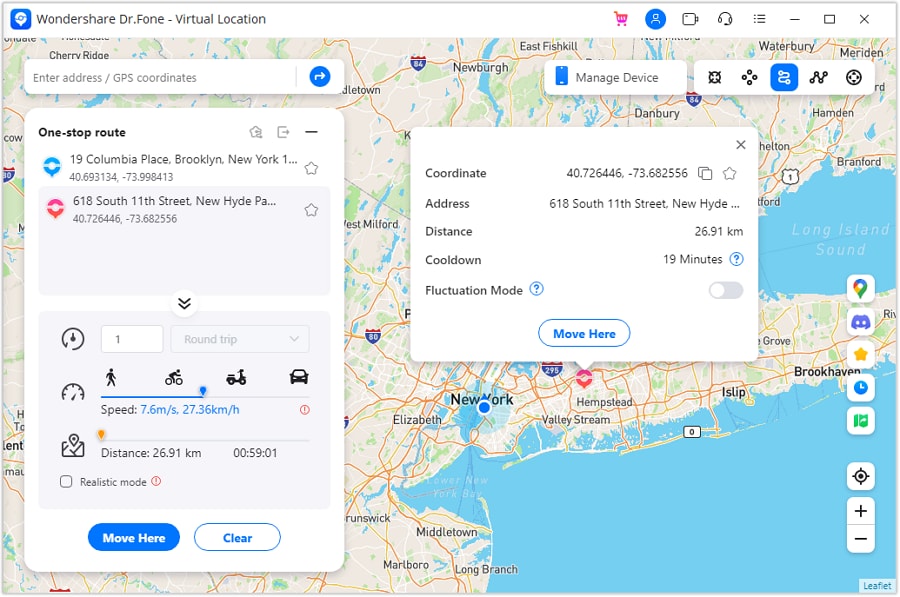
Step 4: Dr.Fone Virtual Location allows you to choose the simulation speed – you can select walking, cycling and a four-wheeler to simulate those speeds. Click Move Here.
Step 5: In a new popup, choose if you want to route to repeat and select the number of times. Click Match to start.
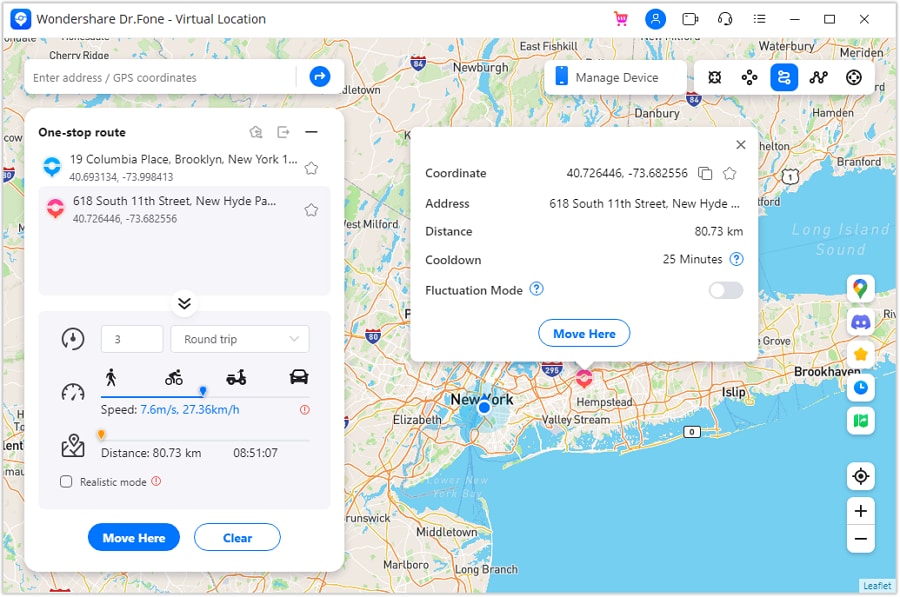
You should now see your location dot moving along your chosen route at the speed you selected. Open Pokémon Go and start catching!
Simulating Movement Between Multiple Points
Similarly, you can simulate between multiple points to play elaborate pranks on your friends and family. If you simply spoof your location to another point as shown previously, they might not believe it. But, if you show movement from one location to another, they can’t deny that, can they? This movement simulation also helps with games such as Pokémon GO.
Step 1: Click the icon at the top right (looks like italicized N)
Step 2: Start clicking the points you want to simulate movement from and through. NOTE: Simulate movements as would happen in real life otherwise game algorithms will catch up and you are liable to get banned for cheating.
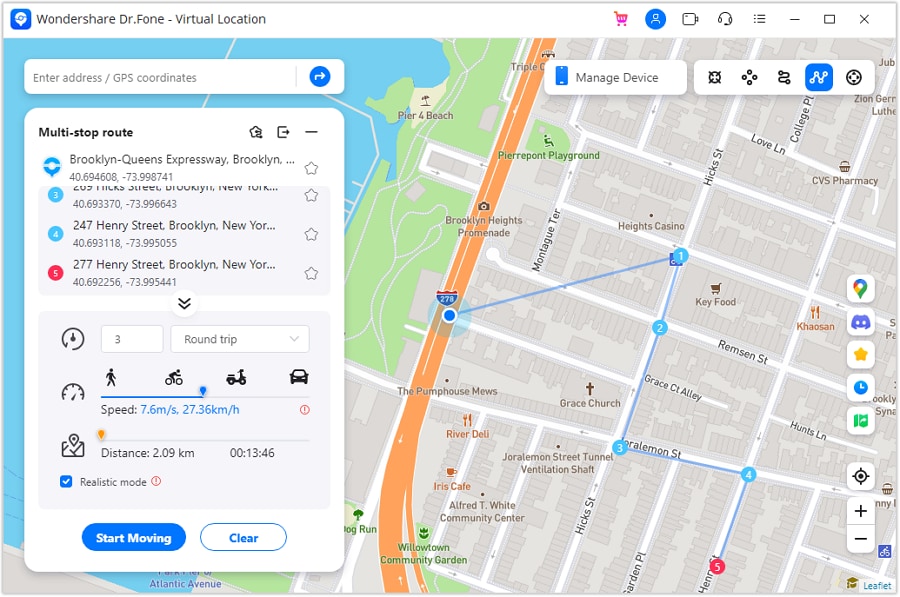
Step 3: Distance gets re-calculated after each selection. When you are satisfied with your route simulation, click Move Here.
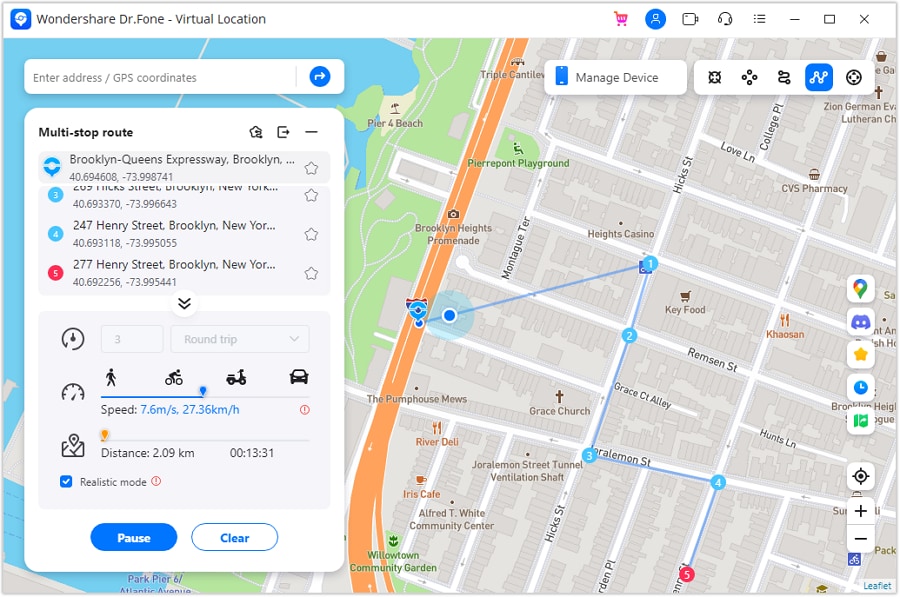
Step 4: Choose if you want to repeat this route and click Match to start the fun.
You can watch the video below to get your location changed on your Motorola G54 5G with Wondershare Dr.Fone
Part IV: FAQs
Here are some commonly asked questions to help you with location spoofer Motorola G54 5G apps.
FAQ 1: Will a location spoofer Motorola G54 5G app damage my Motorola G54 5G or its GPS?
Not in the least. Dr.Fone Virtual Location spoofer on Motorola G54 5G works from the computer and does not affect either the Motorola G54 5G or the GPS chip inside the Motorola G54 5G. So when you want to come back to your real location, all you need to do is restart the Motorola G54 5G.
FAQ 2: Do I need to jailbreak to use a location spoofer Motorola G54 5G app?
Can’t say for other apps in the market, but Wondershare Dr.Fone – Virtual Location does not require you to jailbreak your Motorola G54 5G. It works using the computer to temporarily change the GPS coordinates of your Motorola G54 5G, and you can stop spoofing your location anytime by simply restarting your handset. It does not cause security issues with iOS or risk your privacy at all.
FAQ 3: Can I jailbreak Motorola G54 5G to spoof location using Cydia?
The jailbreakers are only catching up to iOS 15 right now. It is being reported that they are close to jailbreaking iOS 15. As you are running iOS 16, you cannot jailbreak Motorola G54 5G to spoof location using Cydia. Furthermore, jailbreaking is not recommended in today’s age given the security and privacy risks it poses.
Conclusion
Location spoofer Motorola G54 5G apps are gaining prevalence today mostly among gamers who use these GPS spoofer Motorola G54 5G apps to catch more Pokémon. However, anyone can use a location changer on Motorola G54 5G for several other benefits such as breaking the geo-restrictions in dating apps and streaming websites to find dates outside your city limits for free and accessing a catalog of movies and TV shows that is not available in your region due to licensing or other considerations. There are several Motorola G54 5G location spoofer apps in the market, each extolling its virtues. None of them, however, come close to Wondershare Dr.Fone - Virtual Location spoofer on Motorola G54 5G given its intuitive interface and ease of use. Not only can you use it on iOS 16 without problem as this app works from a computer, but you also do not have to think about security issues that jailbreaking a device brings because Dr.Fone Virtual Location changer on Motorola G54 5G works without jailbreaking the Motorola G54 5G.

- Title: Prevent Cross-Site Tracking on Motorola G54 5G and Browser | Dr.fone
- Author: Ava
- Created at : 2024-08-01 20:45:47
- Updated at : 2024-08-02 20:45:47
- Link: https://fake-location.techidaily.com/prevent-cross-site-tracking-on-motorola-g54-5g-and-browser-drfone-by-drfone-virtual-android/
- License: This work is licensed under CC BY-NC-SA 4.0.


 OtsAV Radio Webcaster
OtsAV Radio Webcaster KoolReport Pro is an advanced solution for creating data reports and dashboards in PHP. Equipped with all extended packages , KoolReport Pro is able to connect to various datasources, perform advanced data analysis, construct stunning charts and graphs and export your beautiful work to PDF, Excel, JPG or other formats. Plus, it includes powerful built-in reports such as pivot report and drill-down report which will save your time in building ones.
KoolReport Pro is an advanced solution for creating data reports and dashboards in PHP. Equipped with all extended packages , KoolReport Pro is able to connect to various datasources, perform advanced data analysis, construct stunning charts and graphs and export your beautiful work to PDF, Excel, JPG or other formats. Plus, it includes powerful built-in reports such as pivot report and drill-down report which will save your time in building ones. 

 The BootIt Collection covers multi-booting, partitioning, and disk imaging on traditional PC’s using the standard BIOS and newer PC’s using UEFI. The collection includes BootIt Bare Metal (BIBM) for standard BIOS systems and BootIt UEFI (BIU) for UEFI system.
The BootIt Collection covers multi-booting, partitioning, and disk imaging on traditional PC’s using the standard BIOS and newer PC’s using UEFI. The collection includes BootIt Bare Metal (BIBM) for standard BIOS systems and BootIt UEFI (BIU) for UEFI system.

.png) Kanto Player Professional
Kanto Player Professional With Screensaver Wonder you can easily make a screensaver from your own pictures and video files. Create screensavers for your own computer or create standalone, self-installing screensavers for easy sharing with your friends. Together with its sister product Screensaver Factory, Screensaver Wonder is one of the most popular screensaver software products in the world, helping thousands of users decorate their computer screens quickly and easily.
With Screensaver Wonder you can easily make a screensaver from your own pictures and video files. Create screensavers for your own computer or create standalone, self-installing screensavers for easy sharing with your friends. Together with its sister product Screensaver Factory, Screensaver Wonder is one of the most popular screensaver software products in the world, helping thousands of users decorate their computer screens quickly and easily.